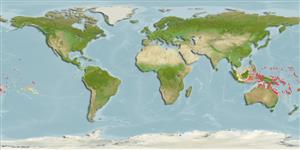>
Ovalentaria/misc (Various families in series Ovalentaria) >
Pomacentridae (Damselfishes) > Pomacentrinae
Etymology: Amphiprion: Greek, amphi = on both sides + Greek, prion, -onos = saw (Ref. 45335).
More on author: Bleeker.
Environment: milieu / climate zone / depth range / distribution range
Ökologie
seewasser riff-verbunden; standorttreu; tiefenbereich 1 - 18 m (Ref. 1602). Tropical; 10°N - 30°S
Pacific Ocean: Eastern Indonesia (Bali and Sulawesi eastward), south-eastern Philippines, Papua New Guinea, eastern Queensland, Coral Sea, Solomon Islands, Vanuatu, New Caledonia Palau and Islands of Micronesia.
Length at first maturity / Size / Gewicht / Alter
Maturity: Lm 5.0, range 5 - 5.5 cm
Max length : 12.0 cm TL Männchen/unbestimmt; (Ref. 9710); max. veröff. Alter: 5 Jahre (Ref. 237)
Rückenflossenstacheln (insgesamt): 10; Rückenflossenweichstrahlen (insgesamt): 16-18; Afterflossenstacheln 2; Afterflossenweichstrahlen: 13 - 14.
Adults inhabit lagoon and outer reef environments. Feed predominantly on planktonic copepods and algae. Oviparous, distinct pairing during breeding (Ref. 205). Eggs are demersal and adhere to the substrate (Ref. 205). Males guard and aerate the eggs (Ref. 205). Associated with the anemones: Entacmaea quadricolor (usually), Heteractis crispa (occasionally), and Heteractis magnifica (rarely) (Ref. 5911). Has been reared in captivity (Ref. 35404, 35413, 35420).
Benthic spawner. Oviparous, distinct pairing during breeding (Ref. 205). Eggs are demersal and adhere to the substrate (Ref. 205). Males guard and aerate the eggs (Ref. 205). Also Ref. 7471.
Allen, G.R., 1991. Damselfishes of the world. Mergus Publishers, Melle, Germany. 271 p. (Ref. 7247)
IUCN Rote Liste Status (Ref. 130435)
Bedrohung für Menschen
Harmless
Nutzung durch Menschen
Fischereien: kleinfischerei; Aquarium: Kommerziell
Mehr Information
ReferenzenAquakulturAquakultur ProfilZuchtlinienGenetikElectrophoresesVererbbarkeitKrankheitenVerarbeitungNutrientsMass conversion
Tools
Zusatzinformationen
Download XML
Internet Quellen
Estimates based on models
Preferred temperature (Ref.
123201): 25.1 - 29.3, mean 28.7 °C (based on 1672 cells).
Phylogenetic diversity index (Ref.
82804): PD
50 = 0.5000 [Uniqueness, from 0.5 = low to 2.0 = high].
Bayesian length-weight: a=0.02239 (0.01314 - 0.03813), b=3.03 (2.88 - 3.18), in cm total length, based on LWR estimates for this species & (Sub)family-body (Ref.
93245).
Trophic level (Ref.
69278): 2.3 ±0.0 se; based on diet studies.
Generation time: 2.1 ( na - na) years. Estimated as median ln(3)/K based on 1
growth studies.
Widerstandsfähigkeit (Ref.
120179): mittel, Verdopplung der Population dauert 1,4 - 4,4 Jahre. (K=0.53; tm=1.67; tmax=5; Fec=7,200).
Fishing Vulnerability (Ref.
59153): Low vulnerability (25 of 100).
Nutrients (Ref.
124155): Calcium = 107 [53, 172] mg/100g; Iron = 0.751 [0.457, 1.271] mg/100g; Protein = 18 [17, 19] %; Omega3 = 0.101 [0.060, 0.166] g/100g; Selenium = 22.6 [12.3, 44.2] μg/100g; VitaminA = 84.9 [20.9, 314.2] μg/100g; Zinc = 1.93 [1.30, 2.86] mg/100g (wet weight);
